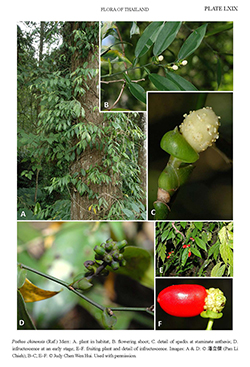e-Flora of Thailand
Volume 11 > Part 2 > Year 2012 > Page 255 > Araceae > Pothos
1. Pothos chinensis (Raf.) Merr.
J. Arnold Arbor. 24: 210. 1948; Schott, Prodr. Syst. Aroid.: 564 (sub. P. seemanii) 1860; Engl. in A.DC. & C.DC., Monogr. Phan. 2: 83, 85 (sub. P. cathcartii & P. seemanii). 1879; Hook.f., Fl. Brit. India 6: 552 (sub. P. cathcartii). 1893; Engl. in Engl., Pflanzenr. IV, 23B (Heft 21): 27–30, Figs. 10–12 (sub. P. balansae, cathcartii, seemanii, warburgii & yunnanensis). 1905; Gagnep. In Lecomte, Fl. Indo-Chine, 6: 1086–1087 (sub. P. balansae, cathcartii, & yunnanensis). 1942; Hu, Dansk Bot. Ark. 23: 413–414. 1968 (sub. P. cathcartii & seemanii); Boyce, Blumea 45: 155. 2000; Thai Forest Bull., Bot. 37: 17. 2009; Li & Boyce in Li et al., Fl. China 23: 7. 2010.— Tapanava chinensis Raf., Fl. Tellur. 4: 14. 1837. Plate LXIX.
Accepted Name : This is currently accepted.
Synonyms & Citations :
Description : Small to very large, slender to robust, homeophyllous root-climbing hemiepiphyte to 10 m. Stem weakly four-angled, slightly compressed or terete in cross-section, mid-green, becoming greyish brown with age; fertile shoot often branching to three or more orders. Leaves many; petiole broadly winged, obovate-oblong to linear-oblong or elongate-triangular, 5–14 by 0.5–2 cm, with 2–3 secondary veins and numerous veinlets per side, base decurrent to clawed, apex truncate, rounded or auriculate; leaf blade ovate to elliptic or lanceolate, 3–21 by 1.5–25 cm, leathery, drying chartaceous. Flowering shoot much abbreviated, arising from most of the midto distal leaf axils of fertile shoots, bearing a minute prophyll and a few 3–15 mm sequentially longer cataphylls. Inflorescence 1–2 together; peduncle rather stout, 3–25 by 1.5–2.5 mm, erect to variously curved, green to brown-tinged; spathe 4–12 by 4–10 mm, ovate, concave, margins in-rolled, base cordate, clasping and slightly decurrent on the peduncle, apex hooded to recurved, acute to subacute with a rather stout mucro, greenish white to green, occasionally faintly purpletinged, somewhat waxy; spadix stipitate; stipe terete in cross-section, 5–10 by 1–1.25 mm, erect, straight, green; fertile portion globose to ovoid, 3.5–13 by 3–10 mm, pale green to white; flowers ca 1–2 mm diam. Infructescence with 1–5 berries; fruit obclavate to ovoid or ellipsoid, 1–1.8 by 1–1.4 mm, mid-green ripening to scarlet, often with basal chartaceous tepal remains.
Thailand : NORTHERN: Chiang Mai, Chiang Rai, Nan, Lampang, Phrae, Tak, Phitsanulok; NORTH-EASTERN: Phetchabun, Loei; EASTERN: Nakhon Ratchasima; SOUTH-WESTERN: Kanchanaburi; CENTRAL: Saraburi, Nakhon Nayok; SOUTH-EASTERN: Prachin Buri, Chanthaburi; PENINSULAR: Phangnga.
Distribution : Nepal through NE India and Bhutan, Bangladesh, Myanmar to SW China (types of Pothos cathcartii, P. chinensis var. lotienensis, P. seemanii, P. warburgii and P. yunnanensis), including Hong Kong (type), Cambodia, Laos, Vietnam (type of P. balansae), Taiwan.
Ecology : On rocks and trees and in clearings in tropical or subtropical primary or disturbed lowland wet or dry evergreen forests, rainforests, sandstone, limestone, granite, clay, loam or sandy soil; 250–1,970 m alt.
Vernacular : Kho kio yan (คอกิ่วย่าน)(Surin); tong ngum (ตองงุม), khak khep (คากเข็บ), tun wa (ตนวา), wai takhep (หวายตะเข็บ)(Chiang Mai); wai tamoi (หวายตะมอย)(Nakhon Ratchasima); ta khap khiao (ตะขาบเขียว)(Loei); phlu chang (พลูช้าง)(Peninsular); hmab-ntsua-nees (มาบซัวนี)(Hmong, Nan).
Uses: Used fresh and applied topically on insect and animal bites (Brun et al. 502); decoction from entire plant used in bath to treat tumours (Brun et al. 704) and drinking for anticough (Anderson 5572).
Notes: Confusion between Pothos chinensis and P. scandens is possible. In flower P. chinensis is immediately recognizable by the straight, not bent, stipe and the generally larger, paler, fewer, more scattered inflorescences. Additionally, P. scandens produces solitary inflorescences whereas P. chinensis frequently produces inflorescences in pairs. Generally P. scandens has flowering shoots arising at many of the leaf axils of long pendent fertile shoots, thus there are often numerous inflorescences. By contrast, P. chinensis tends to produce flowering shoots only in the most distal leaf axils of short spreading fertile shoots, thus inflorescences are rather few. Inflorescence colours also differ; purple spathe and cream fertile spadix in P. scandens, green spathe and white to yellow fertile spadix in P. chinensis. Field observations have detected a faint sweet odour from inflorescences of P. chinensis but no detectable odour from P. scandens. Sterile material of P. chinensis can be difficult to differentiate from P. scandens. Generally the petioles are less than half as long as the leaf blade, and the leaf blade is twice or more as broad as the petiole. However, variation is such that intermediates are common. A feature noted in P. chinensis but yet to be recorded for P. scandens, is the occurrence of flagelliform foraging shoots.


